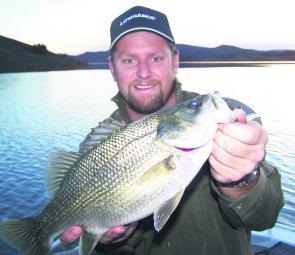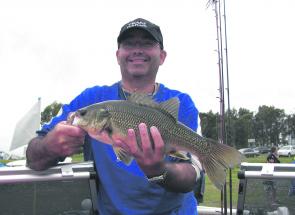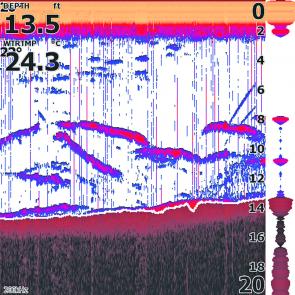We usually experience more pleasant weather patterns from now on but with Summer not really hitting too hard this year, the conditions might change a little later this year.
The dams and rivers have been fishing well and with the milder weather, the fish tend to stay on the bite over a wider window.
The lower Hunter, Paterson and Williams rivers all have plenty of flow and there have been good catches of bass and mullet.
This month will be the last for the surface bites as insect activity drops off and the bass tend to congregate in the deeper sections before moving downstream.
There are plenty of topwater lures in the tackle shops these days but this month those resembling cicadas and grasshoppers are very good options.
My favourites over recent weeks have been the Smith Bisen and Megabass Siglett. These are quite expensive but they certainly give results.
During March the rivers can get a little discoloured from rain so 1/4oz spinnerbaits, blades and 50mm lipless crankbaits are good choices in deeper sections.
Up at the Barrington Tops there have been good catches of rainbow and brown trout, with worms and lures accounting for most. The good times should continue there, too.
Lostock Dam has been fishing well since the start of the year with the majority of the fish coming from the lower section along the banks on spinnerbaits and 1/4oz Beetle Spins.
Glenbawn and St Clair are still holding near full and the water in both is dropping slowly to around 24°, making the bass move from the edges out into the deeper water where they school up as if they were preparing to spawn.
St Clair has been really fishing well, with the water cooling slowly and oxygen levels rising.
There has been some good surface action early and late in the day, with the evening bite lasting well into the night.
The bass are working from the edges out around the vast weed beds in around 7m.
The edge bite is best targeted with plastics rigged on Beetle Spins, surface lures and very shallow hardbodies. Suspending jerkbaits worked between the edge and the weed also work; I have found the Jackall Squirrel and Soul Shad ideal for this.
As the day progresses, target fish in the weed with lipless crankbaits, spinnerbaits and shaker blades like Mumblers; these do not get hung up easily.
On my lipless crankbaits in very heavy weed I replace the trebles with W hooks and run my braid straight through – it will cut through the weed.
Outside the weed in the open water in around 7m to 8m it can be productive to troll along the drops with deep hardbodies or 5/8oz to 3/4oz spinnerbaits.
The bass can also move out into 10m to 15m, where I can see them very easily on down in the water column on my Lowrance HDS with Structure Scan.
When fishing these deep suspended schools I set the unit to manual mode, which bypasses digital depth to give me better control of ping settings. The sounder sends pings only to the depth range you select, making it easy to get the best scroll speed and screen resolution for suspended fish. Select manual mode from the sonar settings menu and press enter to turn manual mode on/off.
These deep schooling bass can be very reluctant to bite. Some days they take blades dropped down and other days it’s small plastics on light jigs. Very light leader, around 2kg and 4m to 5m long is essential, as is a very sensitive rod; these fish are not very aggressive feeders.
These deep fish are usually around changes in the bottom depth from 7m to 15m. Hot spots are along the old river beds up the arms and in the main basin out in the deeper sections off the points where there can be some form of current flow from the wind.
Yabbies and worms are always good as we lead into Autumn; try around some of the deeper banks where there are a few trees.
At Glenbawn silvers and goldens will take worms and the bass love yabbies and shrimp.
If targeting the silvers, which are heaps of fun with the kids, the trees in 7m to 8m up around the Narrows and the Eagles Nest are good. In past years some of the trees were out of the water but now very accessible.
The bass can be very active, moving around the dam, and so a lot of sounding will be necessary. The back of the dam will be good if there has been some inflow; try down around the bottom of the dam if it is falling or constant.
This dam doesn’t have as much weed around the banks and fish are more inclined to be around the timber and off long points.
These fish are best targeted with surface and suspending lures in low light periods and spinnerbaits and crankbaits as it gets lighter.
As the water cools slowly and the bass can be seen out in 10m to 15m, blades, ice jigs and plastics would be the plan with on light line and sensitive rods. Often some of the areas the bass hold can be a few degrees warmer on the surface.
Trolling can help you find these fish in open water and locate the schools of bait the bass are hunting. Lures that get down around 7m on 10lb braid will be required. Good colours this month are black/silver and gold if the water remains very clear.
Reads: 1958
Blair Whitney with a Glenbawn bass caught on a blade in around 12m. They’ll be out deep at times this month.

David Aseguinolaza of Orange used a deep plastic to catch this St Clair bass.

This sounder shot shows bass in cooler water along an edge feeding on gudgeons up near the surface.




